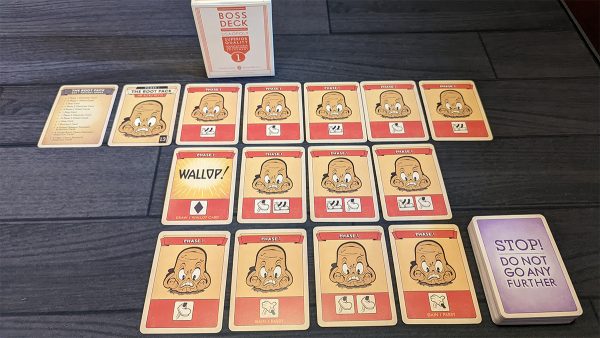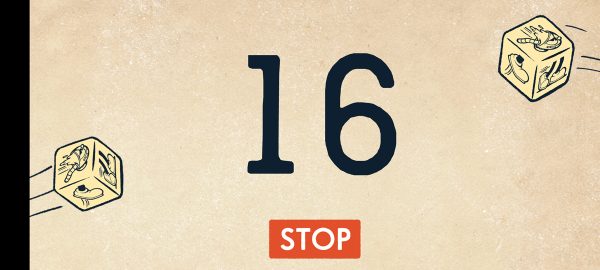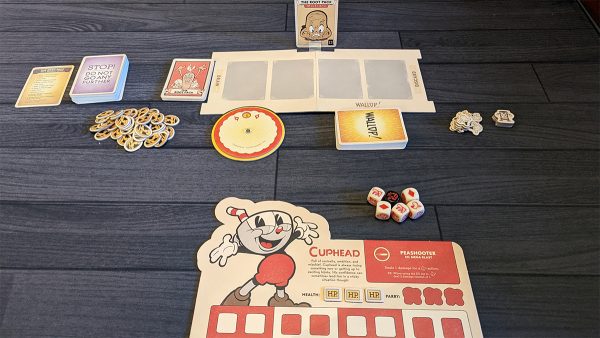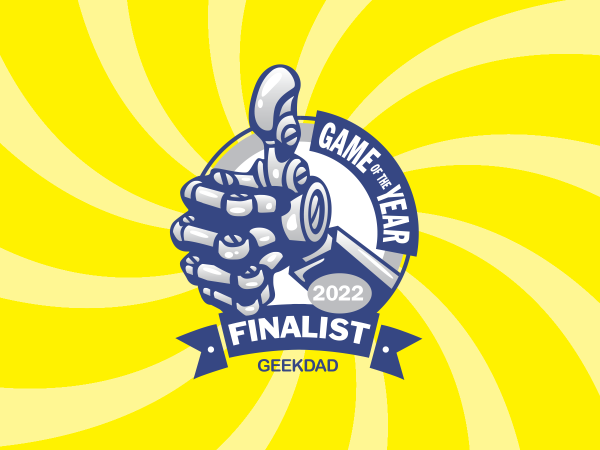Cuphead, for those uninitiated, as a fast-paced video game with ’30s-style cartoon graphics that is fast-paced, fun … and seemingly impossible to beat. Now, every aspect of that game, from the art style, to the pacing, to the difficulty, can be played on your tabletop.
What Is Cuphead: Fast Rolling Dice Game?
Cuphead: Fast Rolling Dice Game is a game for 1–4 players, ages 12 and up, and takes about 20 minutes to play. It’s currently available on Amazon and other fine retailers. (Note that as an affiliate, I may earn on qualifying purchases.)
Cuphead: Fast Rolling Dice Game was designed by Pat Marino and published by The Op, with illustrations by Stephen deStafano.
Cuphead: Fast Rolling Dice Game Components
Inside the box, you’ll find:
- 4 player boards
- 20 action dice
- 4 EX action dice
- 1 boss health dial
- 30 wallop cards
- 1 boss board
- 16 health tokens
- 12 parry tokens
- 40 coin tokens
- 5 time tokens
- 8 boss battle card decks
- 4 super art envelopes
- 1 pad of score sheets
- 1 plastic boss stand
- 1 special dice and pawn in box 7

All of the components are of the highest quality.

The player and boss boards are all 3mm thick cardboard. While the majority of the layout of the player boards is the same, each has a large image of one of the game’s heroes, and the board is die cut to a custom shape for the character. They are all nicely laid out, with lots of space for the various dice and tokens that will end up being placed on them.

The boss board, which folds in half to fit in the box (although it’s actually only about an inch too long when laid out) has four spaces for the boss cards, but also cutouts to place the draw and discard piles and boss standee. Where these actually go would have no impact on game play, but I always appreciate when games provide extra things like those cutouts.

The boss health dial is made of two pieces of 3mm cardboard bound together with a sturdy plastic connecting piece. It comes pre-assembled. The upper dial is loose enough to spin easily on the bottom.

The 24 action dice are all custom d6. The 20 regular dice–5 for each of the 4 player colors–are all identical. Here, the designers came up with exactly 6 icons that need to be rolled, so the odds of getting any one particular icon are always the same. The 4 “EX” dice have the same icons as the regular dice, but are black.

The wallop cards provide ways to store symbols from the dice for later use in the game. They also provide extra powers. The design of the cards is nice and simple, with no extraneous text or images that might distract from their purpose.

The health, parry, coin and time tokens are the same 3mm cardboard as the boards, and maintain the game’s aesthetic.

The biggest set of components are the 8 decks of boss battle cards. Each comes in its own slipcase. Deck 1 contains 60 cards, divided into three phases of bosses to beat, 3 character cards, a few extra cards to explain things, and 12 “Porkrind’s Emporium” cards that provide additional weapons players can purchase at the end of the round to help in later rounds. Most of the cards are the attack cards, which depict one of the enemies from the video game along with one or two spaces to show the dice needed to parry it.

Progressively revealing new rules has been a hallmark of video games for a very long time, but is generally underused in tabletop games. Cuphead uses this technique by adding in rules and mechanics as you open each new box. For deck 2’s boss, you use two of the icons on the dice to represent flying up or down. This 54 card deck includes 4 more weapons from the Emporium. Likewise, deck 3’s 51 cards introduce yet another mechanic–this one, a bit of dexterity–and more new weapons.

Deck 4’s 68 cards make it the largest deck you’ve encountered so far, with a return to deck 2’s aerial maneuvers and the potential for extra damage. Decks 5 and 6 slim back down to only 40 and 41 cards respectively. Deck 5 once again introduces a mechanic that forces players to pay more attention when placing their dice, while in deck 6 brings in a new rule that only reveals an enemy once the other enemies are defeated. All three of these decks also continue to provide more new weapons.

Deck 7 comes in the largest of the boxes, with a whopping 108 cards, plus a few additional physical components (they aren’t in the slipcase, but are included with the game.) If you manage to navigate that box, you only need to fight your way through a mere 26 cards in the eighth and final deck to complete the game.
Two quick notes on the cards. First, the way the cards are organized into separate boxes, with new rules and mechanics being introduced, gives Cuphead a bit of a feel of a legacy game. But this isn’t the intent. Nothing I’ve mentioned above is a “spoiler,” and there’s nothing in the rule that says that you have to start with box 1 and work your way through to box 8 with the same group of players. Certainly, there’s no destroying of cards or placing stickers or doing anything else that would mean you are only intended to play through once. Each deck also includes instructions as to how to reset it, to make it easier to play that deck again. Instead, the packaging is, in my eyes, meant more to invoke the progressive reveal of the video game: you start out with (comparatively) easy opponents and your character can only do a few simple things, but then as you progress the opponents get harder, but likewise your character gains more skills and weapons. I should also mention that it’s entirely possible that the progression in the board game closely, or maybe even exactly, matches that of the video game. As I have never managed to progress past the second level in the video game, I really can’t say.

The game also includes four envelopes with super arts cards–essentially super power-ups–that can be earned and opened as you progress in the game.

Finally, there’s a scorepad to allow you to “save” a game; that is, you can record where you are in the progress of the game, so that you can come back and pick up where you left off. This would be particularly helpful if you are planning to take a group through all eight decks, which would, similar to a legacy game, take a commitment of multiple game sessions.

Each time you play the game, you need a timer that can do 10, 15, or 20 second countdowns. While any timer will do, there is an official app for both Android and iOS that adds sound effects from the video game.
How to Play Cuphead: Fast Rolling Dice Game
You can download a copy of the rulebook here.
The Goal
The goal of the game is to progress through all eight Boss Decks and win all of the boss battles.
Setup

Each player takes a character board and the corresponding dice. They also take three health tokens, which they place on their board.
Place the Boss Board in the middle of the table. Put the time, coin, and parry tokens nearby. Put the Boss health dial in its space under the Boss board. Shuffle the Wallop deck and place it face down in the place indicated on the Boss board.
Open the box for the deck you are going to play. Take the first Boss card and place it on the plastic stand, and then place the standee in the cutout at the top of the Boss board. Set the health dial to the number indicated on the Boss card: the first value if playing solo, the second for two players, the third for three, and the fourth for four. Then, shuffle the Phase 1 Attack cards (up to the “STOP” card) and place them face down next to the Boss board.
Download the official app from Google Play or the App Store. (You can use your own timer, but the sound effects and music from the app add a lot of atmosphere to the game.) Decide if you are going to use a 10, 15 or 20 second timer. The same time setting must be used for the entire Boss deck, but if you move on to another deck, you can choose a different setting.
Gameplay
When you’re ready to begin, deal out the first three cards from the Attack deck and place them face up in the first three spots on the Boss board. If one of the cards is a Wallop! card, deal a fourth card.
Set the timer, make sure everyone is really, truly ready … and then start the timer.

Each Attack card indicates the face of the dice players must roll to defeat that enemy. In early phases, most of the cards have a single icon, but some have two (and as you progress, the cards with two icons become more prevalent.)

Each player, individually, rolls all six of their dice. If they get one that matches the icon on the first enemy card, they dodge that enemy’s attack by placing the die in the corresponding spot on their board. If a card requires two icons, they need to get dice that match both of them. The order of the two die on a double card is not important. Players may roll as many of their dice each turn as they wish. Once a die is placed on their board, however, it is locked there and cannot be changed or rerolled. Players do not have to get both icons on a double card on the same roll. Conversely, players may assign as many dice from a single roll to as many spaces as they wish, so it’s possible with a lucky roll to defeat two or even all three enemies at once.
A player may choose to skip a card, placing matching dice on the second or third set of boxes, but once they do this they can no longer go back to a skipped enemy card, and will therefore take a hit at the end of the round.
If a player rolls the Shoot action–the die face with the pointing finger–they may assign it to the second space on an enemy that only requires one icon. When they do this, they are hitting the Boss himself, and dealing damage to the boss. Note that this placement follows the same rules as the previous placements, so you cannot go back and assign this die to an enemy once you have moved on to the next once. There is no way to assign the Shoot action to an enemy with two icons.
The EX or black die can be used as a regular die at any time. However, if you use it as a Shoot action, it will do double damage. So it can be tempting to save it and keep rerolling it (or, if you roll the Shoot action on it, simply set it aside). But doing so carries that risk that you are rolling one less die each time, thereby reducing the chances of defeating the other enemies.
If the Wallop! card was drawn, players may assign the Diamond dice to it when they reach that spot on their board. If they do this, they can draw a Wallop! card at the end of the round, which will give them a special ability to be used at some point later in the game. There are times, though, when you may need to skip the Wallop! card altogether. If all three of the enemies have two icons, then you will need to use all six dice just to defeat them. And if you don’t need all six, it might be more advantageous to use the extra dice when the Shoot face is rolled to hit the Boss, rather than getting a Wallop! card. This is just one of many choices you have to make while you play.
Some cards allow players to gain a Parry token if that enemy is defeated (by rolling the Parry icon). These tokens are drawn at the end of the round.
Once the timer expires, any dice that were rolled prior to the timer running out may be placed on the board, using the normal rules. Then, the round is over. All players then simultaneously resolve each enemy in order, left to right. Any player who played the correct dice in the correct spots does not take damage. Players who skipped the enemy, or who misplayed dice, take one hit point by removing that token from their board. If a card needed a single icon and a player placed the correct die in the first place and an incorrect die in the second spot, the incorrect die is simply ignored with no penalty. If the player successfully dodged the attack and placed a Shoot die in the second spot, then the boss takes one point of damage, indicated by changing value on the Boss health dial. The boss takes two damage if this Shoot was the EX (black) die.
Any player who played a Diamond on a Wallop! card draws one. Any player who successfully dodged a Parry card takes a Parry token and places it on their board. You cannot have more than three Parry tokens, so if you are able to draw another one once you have three, it is simply ignored.
Once all players have resolved all of their cards, check to see if the Boss still has health left. If it does, discard all of the current Attack cards and deal a new set of three (or four, if the Wallop! card comes up). If players cannot defeat the Boss before all of the Attack cards are played, they reshuffle the Attack deck from the discard pile. However, players must collectively take a Time token any time this happens, which will impact their final score.
If a player loses all three health tokens, they must first discard any remaining Parry tokens they have. Then, a teammate needs to revive them by discarding one of their Parry tokens. A player who has lost all of their health will not take any additional damage this round, but they also cannot draw Wallop! cards or Parry tokens. On the next die rolling phase, they will rejoin the game with one health. If a player loses all of their health tokens and cannot be revived by a teammate, the players lose and the game ends.
When a Boss is reduced to zero health, players move on to the next Boss. All remaining Attack cards are discarded. The Boss is removed from the plastic stand. The next boss–the card right under the STOP card–is placed in the stand. The health dial is set to the correct value for the new boss, the Attack cards are shuffled and dealt as before, and a new round begins.
If this was the last Boss in that deck, then players have achieved a Knock Out! All players are awarded coins as indicated on the Knockout! card. They may then spend these coins in Porkrind’s Emporium on new weapons or they may keep them for future rounds. If the players have met the requirements printed on the outside of the Super Art envelope, they may open it and gain the Super Art card. Prior to the next battle (starting the next deck), players may equip their character with a new weapon, one Super Art card, and one charm.

After a Knockout, players calculate their combined scores. As a group, they get 10 points for each Health token they have remaining, and 5 for each remaining Parry token and for each unused Wallop! card. They lose 10 points for each Time token. They get 10 points if they used a 15 second timer for the battles, and 20 if they used a 10 second timer. They can then give themselves a grade, based on the chart on the back cover of the rules.
Game End
The game ends in a loss for all players if any player loses all of their health and cannot be revived.
The win condition is more up to the players. You can stop after completing any deck, give yourself a grade, and go play something else. Or, you can work through multiple decks (or even all 8 if you’re really determined). The group could also go back and revisit a previously-played deck to see if they can improve their score.

Cuphead: Fast Rolling Dice Game was a 2022 GeekDad Game of the Year Finalist
Why You Should Play Cuphead: Fast Rolling Dice Game
I’m not sure if I’d say that I have ever really enjoyed playing the Cuphead video game. I like the art and the style of the game, but it’s so difficult that it can quickly devolve into frustration. I’ve never gotten very far because I just can’t play it for a long enough period of time.
So while I was glad to see The Op converting it into a board game, I was a bit concerned at first. Could they make a game that truly captured not just the look of the video game, but the feeling of it as well, and yet still make something fun and playable? The answer, as it turned out, is a resounding yes.
Real-time, simultaneous dice rolling games can be chaotic at best. And while Cuphead wouldn’t be Cuphead without a certain degree of chaos, there are a lot of little things that this game does to manage it and make it more controlled chaos. For starters, while it is a cooperative game, it still revolves around everyone doing their own thing. That automatically eliminates the quarterbacking problem present in so many co-ops–there simply isn’t time for anyone to try to dictate what other players should do–but it also means that you don’t have the mad scramble where everyone is trying to play into the same area at the same time and getting in each other’s way. Instead, everyone just needs to put their heads down, focus on their own dice, and try to survive the round.
There is also a lot of strategy, which is a bit surprising for a game that really comes down to a press-your-luck mechanic with six dice. If you roll a die that matches an enemy card you aren’t at yet, do you set the die aside and roll fewer for each previous enemy, thereby reducing your odds of even getting to that one, or do you just keep rolling and hope to roll the right face again? Do you spend that Shoot die on the first enemy, again giving yourself fewer die to roll? If you get the right face for one enemy quickly, do you stay there and keep rolling in the hope of getting a Shoot icon, or do you move on? That’s a lot to consider on each roll, and when you add in the pressure of that timer (and here again, using the app, with its music and sound effects, further heightens the tension).
The game pulls off a couple of other tricks as well. As you move forward, you get new mechanics, even including some dexterity skills, which keeps the game from getting stale even if you try to play through multiple boxes in a single session. It also pulls off a cool stunt of very nicely progressively introducing new rules as you go along. They keep it simple–the rules had to be described on a single card–but again it leverages that feeling from video games that is so often missing in board games where things get more complicated the longer you play.
I guess I shouldn’t have been terribly surprised that I enjoyed this game, given that The Op almost always makes great games, and given my (somewhat grudging) like of the video game, but I was surprised at just how much I like it. It very quickly became a staple of our game nights (and it’s nice that you can pretty much play as much or as little as you want). While it is not for the faint-at-heart–the game can be genuinely stressful–it’s a ton of fun. And to my original concern: it’s dramatically less frustrating to play than its digital counterpart. In fact, I’d go so far as to say that if you wanted to introduce Cuphead to someone, start here with the board game, then bring them into the video game. They’ll probably end up enjoying both a lot more.
Cuphead: Fast Rolling Dice Game is available online and from local game stores.
Click here to see all our tabletop game reviews.
![]() To subscribe to GeekDad’s tabletop gaming coverage, please copy this link and add it to your RSS reader.
To subscribe to GeekDad’s tabletop gaming coverage, please copy this link and add it to your RSS reader.
Disclosure: GeekDad received a copy of this game for review purposes.





